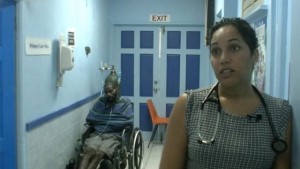
Medical Director at Victoria Hospital Dr. Lisa Charles says there is an increase in the number of young people like Sherman Esnard (in the background) developing COPD.
Read more: http://www.caribbean360.com/news/health-officials-warn-of-deadly-effects-of-combining-marijuana-and-tobacco#ixzz3wZhaefn1
CASTRIES, St. Lucia, Thursday January 7, 2016 – Health officials in St. Lucia are advising against a dangerous practice they say is turning people into “respiratory cripples” before killing them – mixing marijuana and tobacco.
Medical Director at Victoria Hospital (VH) Dr. Lisa Charles said over the past 10 years she has seen an epidemic emerging with an increased number of young patients suffering with Chronic Obstructive Pulmonary Disease (COPD).
She says patients who smoke marijuana mixed with tobacco are developing COPD at a very young age.
“We are talking about young men and women in their 30s with end-stage lung disease. And by end stage lung disease, I mean they are no longer able to carry out any normal activity, such as cooking [or] walking from the bed to the bathroom because of severe shortness of breath,” the doctor said.
COPD is an extremely debilitating, progressive disease which directly affects the lungs. The effects of COPD cannot be reversed. Patients with the disease are literally confined to a bed with oxygen tanks to aid in breathing “because any degree of exertion, any degree of activity causes shortness of breath to the point where you have to stop, you have to sit, you cannot do any of those normal functions that you can do for yourself,” Dr. Charles explained.
The medical director said available bed space at the Victoria Hospital was severely compromised as a result of increasing cases of COPD.
“Upwards of 12 patients per day require some degree of treatment for their breathing difficulty. In terms of patients who are end stage, which is my primary concern, we probably have what we call a revolving-door patient population of close to 15 to 20. These are patients who literally come to A&E either daily or weekly, because their disease is so far progressed that they need that level and that frequency of attention in the emergency department and on the wards,” Dr. Charles disclosed.
“We do also have patients who have lived at VH for the last several months because they can’t take care of themselves at home and they have no option but to stay with us because they need continuous oxygen and full care.”
Sherman Esnard is one of the patients with COPD.
He once earned a living as a carpenter and was an avid football player – activities he can no longer participate in.
“Who wouldn’t miss that? To be a young active fella and you cannot do any of these things again . . .” lamented Esnard.
He spends most of his time between his home and the Victoria Hospital and can’t last a minute disconnected from an oxygen tank.
Dr. Charles said the cost of treating COPD is tremendous, with most of the expense being absorbed by Victoria Hospital, the government and the taxpayers.
“Look at oxygen alone without looking at the nursing cost, the cost of physicians, the cost of other medications, the cost of nebulization, the cost of treating heart failure and the cost of inpatient hospital stays . . . I wouldn’t even know where to start to measure, but it’s very significant,” she said.
The Pan American Health Organization says COPD is a leading cause of morbidity and mortality in the Americas, representing an important public health challenge that is both preventable and treatable. The World Health Organization has designated November 16 annually as World Chronic Obstructive Pulmonary Disease Day.
